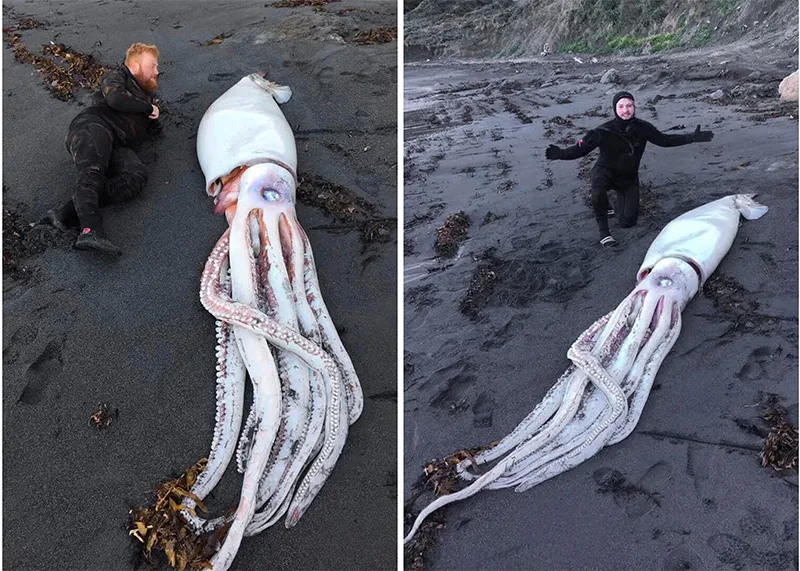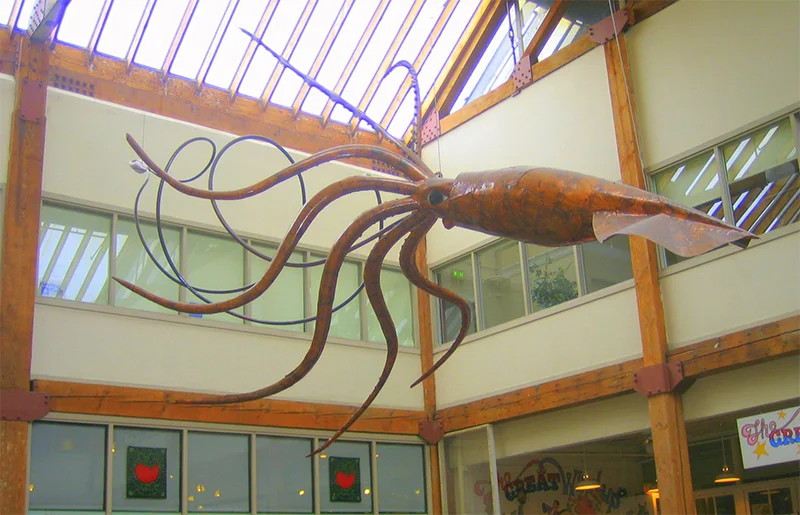
Humans are awed by the rare images of underwater creatures as the globe advances swiftly in technical terms. These puzzling and occasionally horrifying images have the scientific community in awe and excitement.
It is still unknown what lies beneath the deep, black oceans. Ocean masses have fascinated us with their interesting physical characteristics and odd mating habits. And the portion of the ocean that has been investigated by scientists is quite little.
The little that has been learned so far pales in comparison to what is left to be learned. Because of this, scientists get more and more intrigued by the infrequently seen images of underwater species and grow increasingly curious about additional enigmatic aquatic organisms that live beneath the surface.
Let's look at some of the most elusive images of majestic marine monsters.
#1 Pacific Barreleye

The scientific community has been perplexed by this amazing aquatic creature and its translucent head for a very long time. It was originally captured on camera by the Monterey Bay Aquarium Research Institute in 2009. Scientists have discovered that an animal's eyes work like spinning telescopes, allowing them to see things from unusual perspectives.
#2 The Black Sea Devil

Angler fish, sometimes known as the "Black Sea Devil," was captured on camera for the first time ever on November 17, 2014. It was difficult to capture this agile swimmer due to its size. The male angler fish only reaches the size of a pin and has a set of horrifying fangs. Additionally, it was found that the black Sea Devil is a peculiar fish that uses its dorsal fin for propulsion.
#3 The Vampire Squid

It has been nearly impossible to get some of these critters' images due to how deep they live. Deep sea divers went 3000 feet below the ocean's surface in 2005 to get footage of this enormous animal. According to the pictures, the squid may renew and become invisible when it is deep underwater.
Additional investigation yielded even more astounding findings. This newly discovered squid, in contrast to other squid species, is a scavenger that consumes whatever is edible underwater.
#4 The Giant Squid

One of the rarest animals that a human is aware of is the gigantic squid. Scientists have unearthed evidence establishing the existence of enormous squid, which were once thought to be a myth discovered by pirates and fisherman. It is one of the few aquatic animals that demonstrates cannibalism and is a natural predator with a keen tongue that can readily tear apart its prey.

In 2002, a giant squid was captured in its first-ever live photograph in Japan. Later, the National Science Museum of Japan presented a picture of a huge squid residing in its native environment. Its length is 26 feet, and 18 of those feet are made up of tentacles. Later, other organizations videotaped the enormous squid to learn more about the enormous animals that are found in almost all of the world's oceans.
The earliest, well-known pictures of this creature were amassed over the course of around two years' worth of work and 500 photographs. Scientists learned how to hunt and swallow prey from these pictures.
#5 The Glow in the Dark Turtle

Scientists captured the glow-in-the-dark turtle for the first time in 2015. The biofluorescence of this incredible sea creature the capacity to reflect light and produce a glow-in-the-dark effect amazed scientists even more. The fact that these species are critically endangered is one of the main reasons why these aquatic creatures have not been found for a very long time.
These endangered turtles serve as a stark reminder of how human activity has a negative impact on the ocean's natural balance.
#6 Infant Pygmy Blue Whale

The pygmy blue whales have previously been photographed, but never as young. Marine researchers claim that this young Pygmy Blue Whale was originally thought to be rare, with only a few having been seen off the coast of New Zealand. The discovery made in this film may aid conservation efforts as these whales may comeback. Marine biologists have now gained crucial new information on how these whales feed and tend to their young thanks to a new video shot in 2015.
#7 The Frilled Shark

This rare aquatic species is named after its unusual set of needle-like teeth. His mouth has a total of 300 teeth, arranged in 25 rows and facing backward.
In August 2004, a picture of it in its native environment was taken for the first time. Because the frilled shark hasn't typically been mentioned in tales, unlike other sea monsters, scientists know very little about it. Before it was captured on camera in 2004, researchers weren't sure if this endangered species really existed.
These images are of great scientific value since they serve as a reminder that much remains unknown about the ocean.
#8 The Oarfish Aka The Sea Serpent

Oarfish was a bizarre creature that washed up on the San Diego coastline in 2001 and was captured on film by a group of US Navy officers. It was captured in the very first live image, but it quickly passed away after that. Although scientists were aware of its existence, the movement to hang out at depths of at least three thousand feet has made filming it nearly difficult.
#9 The Ghost Shark

A photo that can genuinely frighten you was taken on December 15, 2016, by photography equipment that descended beneath the water over 5000 feet below the surface. This is the first video of the Chimaera ghost shark species, which was not recognized until 2019.
#10 Deepstaria Reticulum

#11 Hadal Snailfish

The first image of this slippery fish, which was thought to be extinct, was taken in 2014. Researchers from the University of Aberdeen who were looking for the animal's habitat took this picture. The second-deepest swimming fish observed and examined by humans is this hadal snailfish.
Source: Weird World

